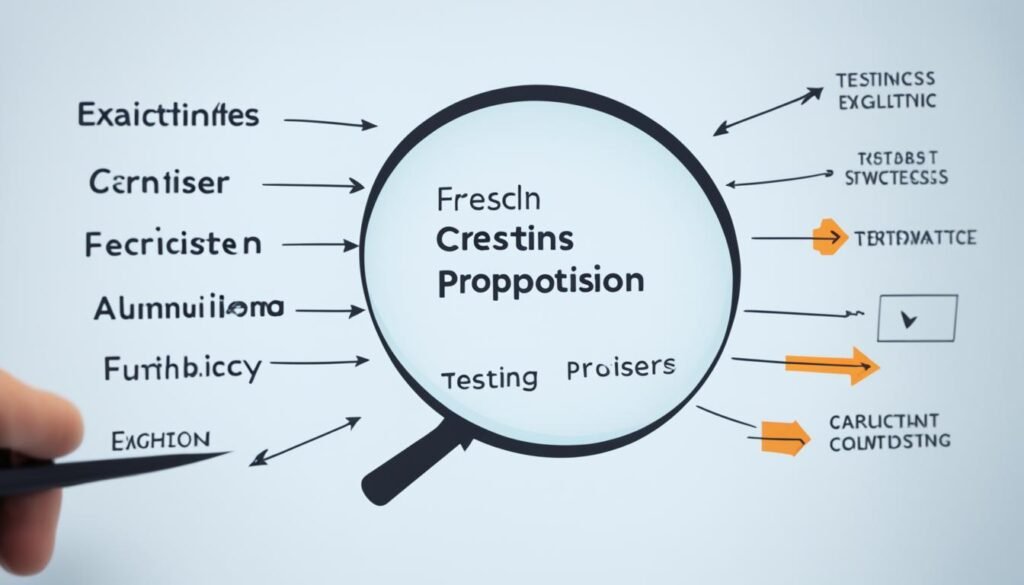Value Proposition Design Your company’s edge in the market hinges on its value proposition. If you can’t show why your product or service stands out, why would customers pick you? A value proposition is a brief statement that explains why buyers should pick your offerings. It’s not just about listing what you sell. It’s about the specific solution you offer and the value you promise to deliver.
A strong Value Proposition Design is key to turning customers into buyers. It shows what makes your products or services unique, sets you apart from others, and explains why you’re the top choice.
Your value proposition is crucial for adding value to customers and standing out in the market. With a strong value proposition, you can share what makes your business unique. This helps you stand out and makes it clear to customers what benefits they’ll get from your offerings.
Table of Contents
Understanding the Value Proposition Design
A Value Proposition Design, also known as a brand proposition or core proposition, is a brief statement. It tells customers why they should pick your products or services. It’s not just a simple description. It’s the specific solution your business offers and the Value Proposition Design customers can expect from you.
Your value proposition sets your business apart from others. It clearly tells your target audience what makes you unique. Without it, customers won’t know why they should buy from you.
What is a Value Proposition?
The value proposition is at the heart of your business plan. It explains the benefits and features that make your product or service perfect for your customers’ needs. To create a good value proposition, first identify your customers’ main problems.
Then, understand your target audience. Use a template to help brainstorm your unique selling points.
Elements of a Value Proposition
A strong value proposition has several key parts:
- Target audience – Who will benefit from your product or service?
- Product or service – What promise does your brand make?
- Benefits and features – How do you stand out from competitors?
- Excellent execution – Can you really deliver on your promises?
Your value proposition must clearly show how your business meets your target customers’ needs better than others. By focusing on these elements, you can craft a compelling value proposition. This will help you attract and keep customers.

Value Proposition Design Process
Crafting a compelling value proposition is key to your business’s success. It means understanding your customers’ main problems and making your offering fit their needs.
Identify Your Customer’s Main Problem
Start by figuring out what your customer’s main problem is. Your team, including customer service, marketing, and sales, can offer insights. Also, looking at use cases can show how urgent and important the problem is.
Understand Your Target Audience
Next, get to know your target audience well. Learn about the problems they face and the hurdles they jump over. Tools like social media and customer reviews can give you a peek into their world. Knowing your audience well helps you make a value proposition that hits the mark.
To wrap it up, the value proposition design process includes:
- Identifying your customer’s main problem through team insights
- Understanding your target audience by digging into their problems and likes
By doing this, you can make a value proposition that speaks to your customers and makes your business stand out.

Crafting the Value Proposition
Crafting a strong value proposition is key to a successful business model. You can use a value proposition template or the value proposition canvas. The aim is to share what makes your brand special and how it meets your customers’ needs.
One way to make a great value proposition is to answer questions from Harvard Business School. You need to know who your customers are, what problems they face, and what price they’re willing to pay. This helps you make a value proposition that speaks to your audience and stands out from others.
Steve Blank’s formula is another good method: “We help (X) do (Y) by doing (Z).” It simplifies your message into something clear and powerful. For instance, “We help busy professionals manage their time better by offering a full time management solution.”
| Value Proposition Approach | Key Elements | Example |
|---|---|---|
| Harvard Business School |
| “We help busy professionals improve their work-life balance by providing a comprehensive time management solution.” |
| Steve Blank’s Formula |
| “We help busy professionals improve their work-life balance by providing a comprehensive time management solution.” |
It doesn’t matter which method you pick, the main thing is to make a value proposition that’s short, engaging, and clearly shows what your brand offers. Focus on what your customers need and their problems. This way, you can make a value proposition that makes your business stand out and keeps customers coming back.

This image from freepik
“Crafting a clear value proposition is crucial for communicating a brand’s unique selling points.”
Validating Your Value Proposition
After making your value proposition, it’s key to check if it works well. This makes sure it connects with your audience and shows the real benefits of your product or service. You can validate your value proposition by running PPC ads, using A/B testing tools like Wynter, or doing customer interviews.
Understanding the customer’s view is a big part of validating your value proposition. You need to know their problems, what hurts them, and what they want to gain. Tools like the value proposition canvas help you see what your customers need and make your proposition fit.
- Run PPC ads to see how interested and engaged your customers are with your proposition.
- Use A/B testing tools to see which value proposition messages work best.
- Do customer interviews to get direct feedback and improve your proposition.
Validating your value proposition is not just something you do once. It’s an ongoing process that needs constant improvement and testing. By always checking your value proposition, you make sure it stays relevant and interesting to your audience. This increases your product or service’s chances of doing well in the market.

Remember, making sure your value proposition is right is key to your business’s success. It helps you avoid mistakes like wrong assumptions about customers, outdated info, and focusing too much on features instead of what customers need. With a strong value proposition and ongoing validation, you boost your chances of offering something valuable that meets your customers’ expectations.
Conclusion
Crafting a compelling value proposition is key to your business model canvas success. It clearly shows what makes your product or service special to customers. This helps you stand out from others, grab your website visitors’ attention, and increase sales.
Creating a strong value proposition takes time and effort. But it’s worth it for the benefits it brings to your business.
By using the steps from this article, you can make a value proposition that clearly shares what your brand offers. Remember, value proposition best practices and knowing the value proposition importance are crucial. They help make a statement that makes you stand out in the market.
Keep working on and testing your value proposition. Focus on what your customers need, their problems, and what they want to achieve. Talk to your audience, get their feedback, and be open to making changes. Until you find a value proposition that really speaks to your ideal customers, keep going.
With a well-made value proposition, you’re on your way to a successful and lasting business model.



